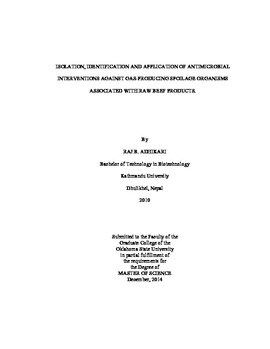| dc.contributor.advisor | Muriana, Peter | |
| dc.contributor.author | Adhikari, Raj B. | |
| dc.date.accessioned | 2016-01-20T15:44:22Z | |
| dc.date.available | 2016-01-20T15:44:22Z | |
| dc.date.issued | 2014-12-01 | |
| dc.identifier.uri | https://hdl.handle.net/11244/25626 | |
| dc.description.abstract | Raw beef products provide a complex niche for colonization and development of a variety of microorganisms that might be present during slaughter and further processing. Lactic acid bacteria (LAB) are generally-recognized-as-safe (GRAS) for human consumption and play an important role in food fermentation and preservation based on the production of lactic acid. Some strains of LAB are known to produce various types of protein inhibitors (i.e., bacteriocins, Bac+) which may be used as antimicrobial agents against susceptible microorganisms. The objective of our study was to isolate and identify gas-producing organisms (Gas+)associated with package bloating of vacuum-packaged fresh beef products, examine incoming raw materials and niches in the meat processing workplace, and identify possible antimicrobial solution interventions to reduce their occurrence in products on retail supermarket shelves. Samples taken from incoming package purge, environmental swabs or the processed meat samples themselves, were enriched in MRS broth and then inoculated into MRS-Durham tubes and incubated for the visual presence of gas production. Gas+ isolates were definitively identified by 16S rRNA PCR and sequencing. Several gas-producing strains were used to inoculate lean beef discs for testing the efficacy of various commercially available antimicrobials (Zesti AM-5, BioVia-CDV, Danisco NovaGARD NR-100, Durafresh 2012, Durafresh 5924), organic acids, and combinations of laboratory-generated bacteriocin (Bac+) preparations from bacteriocinogenic LAB. The dominant Gas+ organisms were found to be Leuconostoc mesenteroides. These organisms were shown to be resistant to nalidixic acid and vancomycin which allowed us to generate selective media to enumerate them during antimicrobial assays on raw beef. Gas-producing organisms are intrinsically supplied to further raw beef processors from their incoming raw beef suppliers and may present problems to their retail products during refrigerated storage. Our study attempted to identify antimicrobial interventions that will reduce or prevent the survival/growth of the Gas+ organisms that could be present on finished raw beef products. | |
| dc.format | application/pdf | |
| dc.language | en_US | |
| dc.publisher | Oklahoma State University | |
| dc.rights | Copyright is held by the author who has granted the Oklahoma State University Library the non-exclusive right to share this material in its institutional repository. Contact Digital Library Services at lib-dls@okstate.edu or 405-744-9161 for the permission policy on the use, reproduction or distribution of this material. | |
| dc.title | Isolation, Identification and Application of Antimicrobial Interventions Against Gas-producing Spoilage Organisms Associated with Raw Beef Products. | |
| dc.type | text | |
| dc.contributor.committeeMember | McGlynn, William | |
| dc.contributor.committeeMember | Ramanathan, Ranjith | |
| osu.filename | Adhikari_okstate_0664M_13741.pdf | |
| osu.accesstype | Open Access | |
| dc.description.department | Food Science | |
| dc.type.genre | Thesis | |
